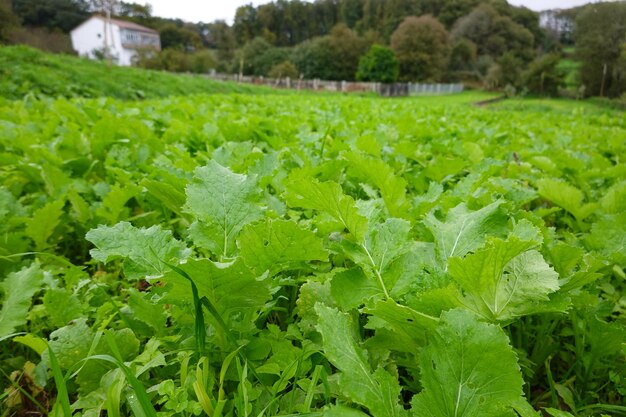Mustard greens, known for their peppery flavor and high nutritional value, are a popular leafy green vegetable that can thrive in various climates. In South Africa, they are gaining popularity among consumers for their versatility in dishes and their health benefits. This article provides a detailed guide for farmers on growing mustard greens from seed to harvest, covering essential inputs, growth stages, pest management, and storage techniques.
1. Choosing the Right Variety
Before starting, select the appropriate mustard green variety based on your local climate and market demand. Common varieties include:
- Savoy Mustard Greens: Known for their crinkled leaves, they have a mild flavor and are often favored in salads.
- Flat Leaf Mustard Greens: These have broad, flat leaves and are commonly used in cooking and stir-frying.
- Asian Mustard Greens: Varieties like Mizuna and Komatsuna are popular in Asian cuisine and can also be cultivated.
2. Land Preparation
Proper land preparation is crucial for growing mustard greens successfully. Here are the steps involved:
- Site Selection: Choose a well-drained field with full sun exposure. Mustard greens prefer cooler temperatures, ideally between 10°C and 20°C.
- Soil Testing: Conduct a soil test to determine pH levels and nutrient content. Mustard greens thrive in soils with a pH of 6.0 to 7.5.
- Tilling the Soil: Clear the area of weeds and debris. Use a tractor or manual tiller to plow the soil to a depth of 15-20 cm. This improves aeration and nutrient mixing.
- Amending the Soil: Based on soil test results, amend the soil with organic matter like compost or well-rotted manure to improve fertility and drainage.
3. Planting Mustard Greens
After preparing the soil, you can proceed to plant your mustard greens:
- Seed Selection: Choose high-quality seeds from a reputable supplier. Consider hybrid seeds for better yield and disease resistance.
- Sowing: Sow seeds directly into the soil at a depth of 0.5-1 cm. Space seeds about 15-30 cm apart in rows that are 30-40 cm apart.
- Timing: Plant in the cooler months of spring (August to October) or autumn (February to April) to avoid heat stress.
4. Watering Requirements
Mustard greens require consistent moisture for optimal growth:
- Irrigation: Ensure soil moisture is maintained. Use drip irrigation or sprinklers to provide even water distribution.
- Frequency: Water the plants about 2-3 times per week, depending on weather conditions. Ensure the soil is moist but not waterlogged, as this can lead to root rot.
5. Fertilization
Proper fertilization is vital for healthy mustard green growth:
- Nitrogen: Mustard greens require nitrogen for leafy growth. Apply a balanced fertilizer (NPK 10-10-10) or a nitrogen-rich organic fertilizer like blood meal at the time of planting.
- Follow-up Applications: Side-dress with additional nitrogen fertilizer 3-4 weeks after planting to promote robust growth.
6. Growth Stages
The growth cycle of mustard greens can be divided into several stages:
- Germination (Days 1-7): Seeds will germinate within 3-7 days if conditions are optimal. Ensure consistent moisture during this period.
- Seedling Stage (Days 7-21): After germination, seedlings will develop their first true leaves. Thin seedlings to about 15 cm apart to allow for proper airflow and growth.
- Vegetative Stage (Days 21-45): During this period, plants will grow rapidly. Regularly check for pests and diseases and manage them as necessary.
- Maturity (Days 45-60): Mustard greens are typically ready for harvest 6-8 weeks after planting. Harvesting can begin when leaves are about 15-20 cm long.
7. Pest and Disease Management
Several pests and diseases can affect mustard greens. Monitor plants regularly and take action when necessary:
- Common Pests:
- Aphids: Small green insects that suck sap from plants. Use insecticidal soap or neem oil for control.
- Cabbage Loopers: Caterpillars that can defoliate plants. Handpick or use Bacillus thuringiensis (Bt) for organic control.
- Flea Beetles: Tiny beetles that cause small holes in leaves. Use row covers to protect young plants.
- Diseases:
- Downy Mildew: A fungal disease that causes yellow spots on leaves. Improve air circulation and avoid overhead watering.
- Black Rot: A bacterial disease causing yellowing of leaves. Rotate crops and ensure proper sanitation.
- When to Use Pesticides: Use pesticides or herbicides only as a last resort and according to the manufacturer’s instructions. Timing is crucial; apply pesticides in the early morning or late afternoon to minimize harm to beneficial insects.
8. Harvesting Mustard Greens
Harvesting should be done at the right time to ensure maximum flavor and quality:
- Timing: Begin harvesting when leaves reach 15-20 cm in length. This typically occurs 6-8 weeks after planting.
- Method: Use sharp scissors or a knife to cut the leaves, leaving the plant’s base intact. This allows for regrowth and multiple harvests.
- Frequency: Harvest regularly to encourage new leaf growth and maintain plant health. Remove any yellow or damaged leaves during harvesting.
9. Storage of Mustard Greens
Proper storage is essential to maintain the quality of harvested mustard greens:
- Cleaning: Rinse harvested leaves thoroughly to remove dirt and insects. Pat dry with a clean towel.
- Storage Conditions: Store mustard greens in a cool, dry place. Ideally, keep them in the refrigerator at a temperature of 0-4°C.
- Packaging: Use breathable bags or containers to allow for airflow. Mustard greens can typically be stored for up to a week.
Growing mustard greens can be a rewarding venture for South African farmers, providing a nutritious crop that meets increasing market demand. By following the steps outlined in this guide—ranging from selecting the right variety to managing pests and diseases—farmers can cultivate healthy mustard greens successfully. Proper planning and management at each growth stage will ensure a bountiful harvest, contributing to sustainable farming practices and enhancing food security in the region.
Join 'Farmers Mag' WhatsApp Channel
Get the latest Farming news and tips delivered straight to your WhatsApp
CLICK HERE TO JOIN






